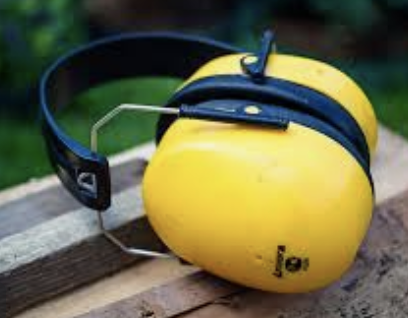Noise
and Hearing Protection
Well Known Fact!
- Individuals exposed to excessive noise over prolonged periods of time will have diminished hearing capacity.
- So why don’t we do more about preventing hearing loss? Possible Reasons
- At some dangerous noise levels, the noise itself is still not painful
- Diminished hearing is not generally perceptible over a short period of time
- PPE may be perceived as too much hassle for a benefit that is not perceived on a day to day basis
- The time between noise exposure and hearing loss is so long that the concern about hearing loss is minor Let’s Talk About Sound
- Noise is reduced at greater distances from the source • Reduction in noise with distance
Decibels = 20 * log (D1/D2) The further you are from the source of the sound, the less intense the noise Consider a Tool that Creates Sound that Declines with Distance - 1 foot
- 2 feet
- 4 feet
- 8 feet
- 16 feet • 32 feet • 64 feet • 128 feet
110 decibels 104 decibels 98 decibels 92 decibels 86 decibels 80 decibels 74 decibels 68 decibels OSHA Permissible Noise Exposures - 8 hours • 4 hours • 2 hours • 1 hours • 1/2 hr
- 1/4 hr
90 db 95 db 100 db 105 db 110 db 115 db When is noise exposure excessive? - Assume noise exposure at 90 db for 6 hours and noise exposure at 100 db for 2 hours
- Equivalent noise exposure factor (Fe)
- Fe = (6 hrs/8 permitted) + (2 hrs/2 permitted) = .75 + 1.0 = 1.75 > 1 (not acceptable) Additional noise created when a second noise source is added
Total db increase Tool Sound Levels (running) - Electric Drill
- Saws All
- Circular Saw
- Router
77 db 98 db 101 db 103 db - Wood Chipper108 db
- Beltsander 109 db • Saber saw • Planer
- Grinder
- Carver
112 db 118 db 119 db
85 db
Noise Levels of Tools Tool Sound Levels (cutting) - Circular Saw (101 db) • Saws All (98 db)
- Router (103 db)
- Electric Drill (77 db) • Beltsander (108 db)
115 db (sawing) 101 db (sawing) 101 db (routing)
83 db (drilling) 111 db (sanding)
Do the manufacturers give the decibel levels to be anticipated? Is this when simply running or when operating? How accurate is the formula in predicting noise decay with distance? - Beltsander at 6 inches is 109 db – at 24 inches it should be 97 db
– this was measured at 103 db
Other tool measurements were similar Note: measurements made indoors, on
concrete Can we accurately judge noise levels? - Probably not
- That is why some rigid protocol on hearing protection is warranted Think Safety Work Safely

